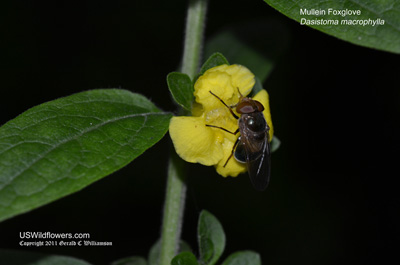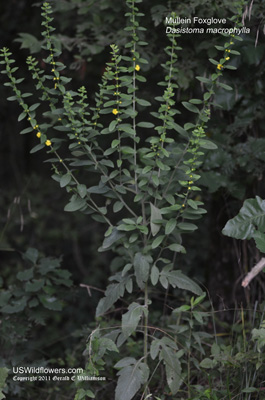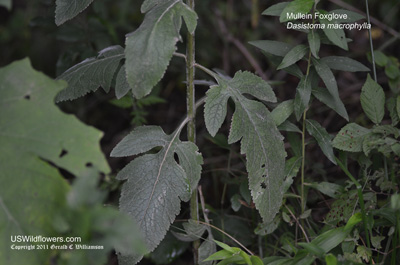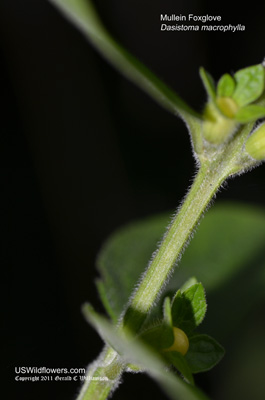Mullein Foxglove, Mullein Seymeria - Dasistoma macrophylla
|
Dasistoma macrophylla - Mullein Foxglove, Mullein Seymeria. This is the only species in the Dasistoma genus. It is hemiparasitic - it will attach its roots to the roots of an oak tree and suck moisture and possibly nutrients from the oak. The common name comes from the similarity of the blossom to Mullein and to False Foxglove. The Mullein similarity is what started me looking in the Figwort family for the identification of the plant after I photographed it in Walker County, Georgia. That is the only county in Georgia where the USDA Plants Database has it ilisted. It has a fairly broad distribution, being found in 22 states. It is officially listed as Threatened in Michigan, and of Special Concern in Georgia and Wisconsin.
Synonym: Seymeria macrophylla
Update 07/22/2012: This is another of the species which has been moved from Scrophulariaceae - the Figwort family - into Orobanchaceae - the Broom-rape family. All parasitic members of Scrophulariaceae have been so moved.
Found in:
AL, AR, GA, IA, IL, IN, KS, KY, LA, MI, MO, MS, NE, OH, OK, PA, SC, TN, TX, VA, WI, WV
Leave comments on Dasistoma macrophylla at this link. | 
Distribution of Dasistoma macrophylla in the United States and Canada:

Blue=Native; Grey=Introduced
Map from USDA Plants Database:
USDA, NRCS. 2017. The PLANTS Database (http://plants.usda.gov, 08 May 2025). National Plant Data Team, Greensboro, NC 27401-4901 USA.
Search Our Database: Enter any portion of the Scientific, Common Name, or both.
Do a general Google search of the entire site:
#ad
 Follow USWildflowers on Twitter
#ad
| | Site: Pigeon Mountain - Blue Hole Area, Walker County, GA Date: 2011-July-16 | Photographer: Gerald C. Williamson
Nikon D7000
Tamron SP 90MM f/2.8 AF Macro | | The yellow blossom has a 5-lobed corolla, with the top 2 lobes generally folded back to some extent. The blossom is similar to False Foxgloves except the False Foxgloves have longer corolla tubes, and the throats to the False Foxglove corolla tubes are open, whereas in Mullein Foxglove, the corolla tube opening is obstructed by numerous hairs. This latter feature is shared with Mulleins. | | 
| | Site: Pigeon Mountain - Blue Hole Area, Walker County GA Date: 2011-July-16 | Photographer: Gerald C Williamson
Nikon D7000
Tamron SP 90MM f/2.8 AF Macro | | Various bees and the occasional butterfly pollinate this plant, but clearly some sort of fly is doing so in this photo. While the leave of Mullein Foxglove are generally not hairy (unlike the stem) except for the scattered hair, note the line of short hairs on the central vein of the leaf in this photo. | | Click on the photo for a larger image

| | Site: Pigeon Mountain - Blue Hole Area, Walker County GA Date: 2011-July-16 | Photographer: Gerald C Williamson
Nikon D60
Tamron SP 90MM f/2.8 AF Macro | | The tall (up to 6 or 7 feet) plant has many branches which terminate in leafy inflorescence. The leaves get much smaller as they rise up the plant, and the uppermost leaves may be entire and sessile. | | Click on the photo for a larger image

| | Site: Pigeon Mountain - Blue Hole Area, Walker County GA Date: 2011-July-16 | Photographer: Gerald C Williamson
Nikon D7000
Tamron SP 90MM f/2.8 AF Macro | | Except for the uppermost leaves, the leaves on Dasistoma macrophylla are on petioles, with the lowest ones being quite long. These leaves may be up to 12 inches long and are lobed. | | Click on the photo for a larger image

| | Site: Pigeon Mountain - Blue Hole Area, Walker County GA Date: 2011-July-16 | Photographer: Gerald C Williamson
Nikon D7000 | | The stem and petioles of the plant are covered with short hairs. It was quite persistent as I bumped the plant repeatedly getting the tripod in place for this photo. | | Click on the photo for a larger image

|
References used for identification and information:
|
|
| |
| #ad
|
|







